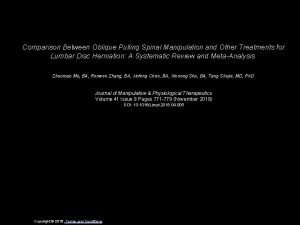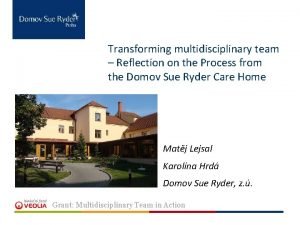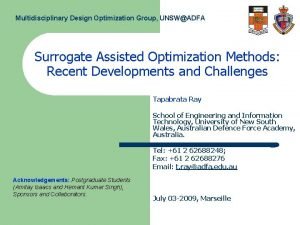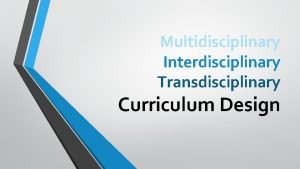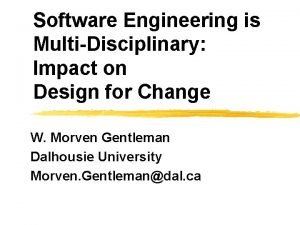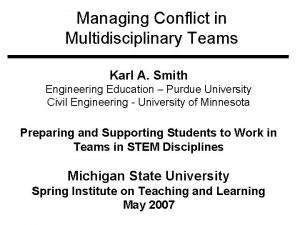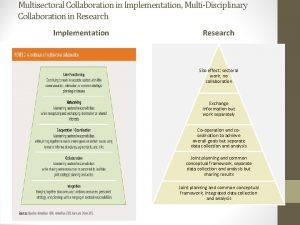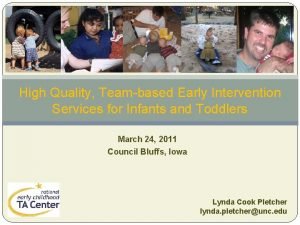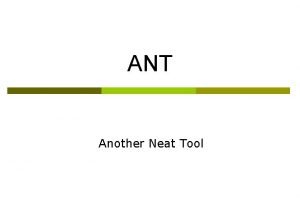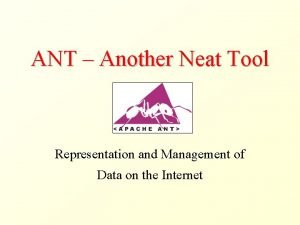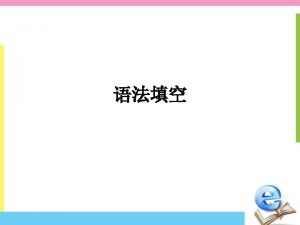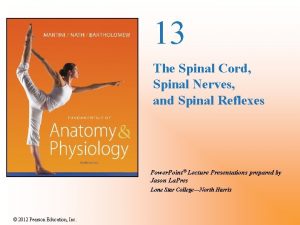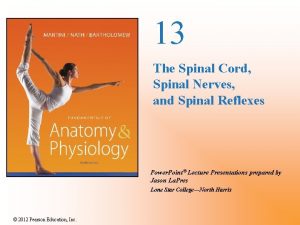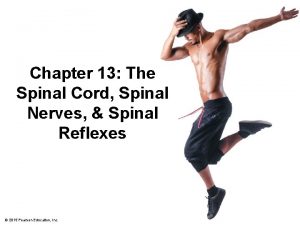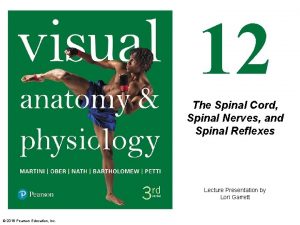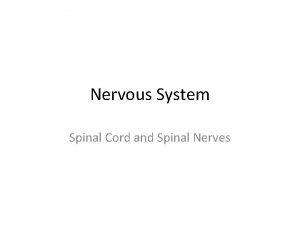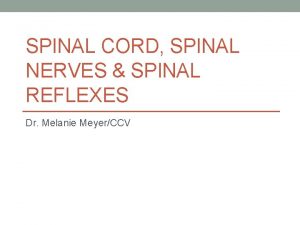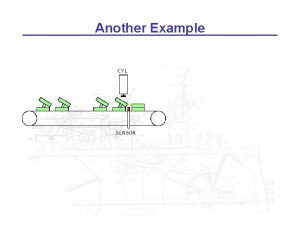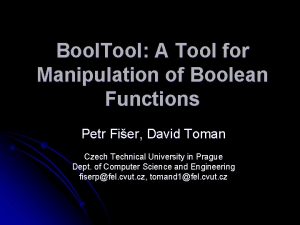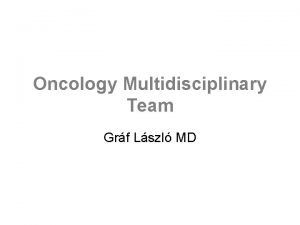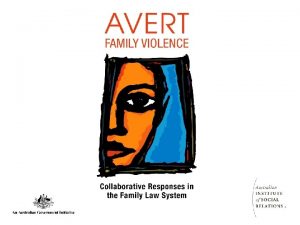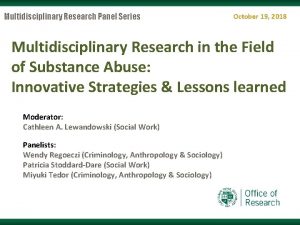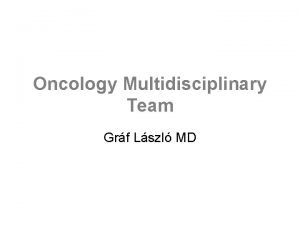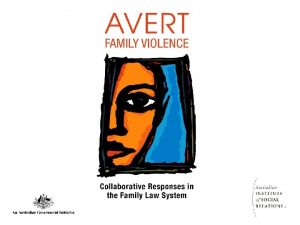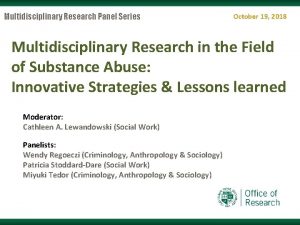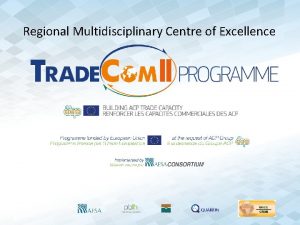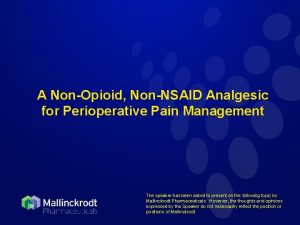Spinal Manipulation Another Nonopioid Tool for your Multidisciplinary







































- Slides: 39

Spinal Manipulation – Another (Non-opioid) Tool for your Multi-disciplinary Pain Management Tool Box. Lecture Goals: To familiarize pain-treating doctors on the potential, application and contraindications for spinal manipulation when treating patients with non-cancer chronic pain. 9/25/2020 International Cloud University: Dale E. Alsager, D. O. , Ph. D. , Interim Dean International Cloud University School of Medicine and Health Science Improving World Health Through Education © 2014 1

By Dale E. Alsager D. O. , Ph. D. Osteopathic Physician & Surgeon © 2012 Osteopathic Medical Services, Inc. _______________________ International Cloud University: Dale E. Alsager, D. O. , Ph. D. , Interim Dean International Cloud University School of Medicine and Health Science Improving World Health Through Education © 2014 2

Disclaimer: I have in the past received remuneration for: • Teaching Assistant (OMM Lab) at Kirkville College of Osteopathic Medicine. (non-paid) (1994) • CME Lecturer on Spinal and Pelvic Biomechanics for the Washington State Osteopathic Association annual convention. (Semiahmoo and Stevenson, WA) • CME Lecturer for Oregon State Osteopathic Medical Association Annual Convention on Spinal and Pelvic Biomechanics and OMT Lecture and OMT demonstration • CME Lecturer for N. W> State Osteopathic Medical Convention (Las Vegas) on “the most common overlooked cause of Low Back Pain and OMT – un-level sacral base. ” (cont’d) 3

• CME Lecturer for New Mexico Osteopathic Association Convention (2011) Short Leg Syndrome, its Diagnosis and Treatment in a Medical Practice. Lecture and Demonstration • CME Lecturer Hawaii Osteopathic Medical Association Annual Convention. Biomechanics affecting Low Back Pain and Treatment guidelines using OMT • Part-Time Guest Lecturer OMM Department at Yakima Osteopathic Medical College (PNWU) Lecture and Lab, three hours • Hired by Chiropractic Group in Kelowna, B. C. to 4 do a feasibility study on starting up a

Because many pain complaints involve mechanical changes (injuries, falls, MVA, etc. ) è Manipulation of hard and soft tissues by skilled practitioners can bring pain relief and often can reduce, and in some cases eliminate, the need for narcotic medications. 5

3 Types of Practitioners è D. O. s – Osteopathic Physicians & Surgeons (OMM, OMT) è D. C. s – Chiropractors è P. T. s – Joint mobilization 6

Comparison of Manipulative Approaches Education & Licensure Osteopathic Physicians Following Bachelor’s level education, four years of osteopathic medical school plus a minimum of one or two years post -doctoral training (plus board exams) required for licensure. All specialty boards available. Unlimited license in all states and U. S. Armed Forces for practice of medicine and surgery in addition to OMT. Chiropractic Physical Therapy Following Associate level education, four years of Chiropractic school (plus chiropractic boards) required for licensure. Master’s level education in Physical Therapy following Bachelor’s degree required for licensure or registration. Limited licensure⁴ for treatment of neuromusculoskeletal system; in some states restricted to spine regions only. Limited license or registration for practice of physical therapy; requires physician referral in some states. 7

Comparison of Manipulative Approaches – Practice Patterns & Practice Basis Osteopathic Physicians Frequency of treatment determined by ongoing evaluation. Typically fewer encounters per patient. “Find it, Fix it, and Leave it alone. ” Utilized by multiple physician specialties. to utilize OMT based on multi-system differential diagnosis; (evaluation and management service to diagnose somatic dysfunction); l. D. O. is responsible for all aspects for patient’s diagnosis and treatment. l. The “Rule of the Artery” prevails. Chiropractic Physical Therapy l. Treatment plan with intermittent reevaluation. l. Higher frequency of treatment. (The “Rule of the Nerve”). l. Treatment plan set by initial evaluation; reevaluated following completion of plan. l. Higher frequency of treatment. Based on effect of spinal misalignment (called “subluxations”) on nervous system function. Diagnosis limited to impairment and functional limitations. l. Decision 8

Comparison of Manipulative Approaches – Coding Distinctions Osteopathic Manipulative Treatment Codes: Chiropractic Manipulative Treatment Codes: Physical Medicine Manual Therapy Code: 98925 Osteopathic manipulative 98940 Chiropractic manipulative treatment (CMT); spinal, one to two regions. 97140 Manual therapy techniques (e. g. , mobilization/manipulation, manual lymphatic drainage, manual traction), one or more regions, each 15 minutes. treatment (OMT); one to two body regions involved. 98926 Three to four body regions involved. 98927 Five to six body regions involved 98928 Seven to eight body regions involved. 98929 Nine to ten body regions involved. 98941 Spinal, three to four regions. 98942 Spinal, five regions. 98943 Extraspinal, one or more regions. **Multiple Differences in Technique and Terminology Exist. ** 9

Not all D. O. ’s Do OMT: è Following graduations from an AOA accredited medical college, D. O. graduates may access all post-graduate specialties (i. e. , dermatology, cardiology, OB-GYN, anesthesiology, family practice, internal medicine, etc. ) è Some D. O. ’s may choose to complete a residency in OMM. (Osteopathic Manipulative Medicine – 2 years. ), or: Board Certification in Neuro-muscular Medicine, (2 year process: exam, case presentations, and research. ) or: Board Certification in Family Practice and OMT, (2 year residency plus written and practical specialty board exam which include proficiency assessment in OMT. ) 10

70% of D. O. ’s end up in Rural Practice. l D. O. ’s traditionally practice in rural settings and training is comprehensive to provide a variety of procedural skills (xrays, etc. ), to prepare D. O. ’s to serve communities where a variety of specialists might not be available. 11

How Osteopathic Manipulation Works: è The science of osteopathy is built around “the rule of the artery”, which stems from an old and very basic principle of physics relating to how fluids move through tubes. 12

The Equation: Flow = π r² … ° π being the coefficient of friction of fluid against the tube wall, ° r being the radius of the tube ° Squared(²) is the square of the radius of the tube (artery). (Cont’d) 13

The Equation: l (cont’d) If you have fluid (blood) passing through a tube (artery) and are able to increase the tube by twice, (doubling the radius of a capillary), the effect on flow is not a doubling, but “squared” which is equivalent to approximately 16 times the flow. The Goal of OMT is simple, and based on science. l If an osteopathic physician can increase the diameter of blood or lymphatic vessels by removing or reducing physical restrictions surrounding them, then the flow of blood to the diseased organ or body part can be increased by the square of the radius of those blood vessels affected. 14

Osteopathic Manipulation l Osteopathic Manipulation has the power to influence the body’s homeostatic regulators – the sympathetic and parasympathetic nervous systems. l Through direct manipulation of peripheral sympathetic and parasympathetic ganglia, osteopathic physicians can affect physiological change by quieting a sympathetic response, or by stimulating parasympathetic signals (including small arterioles that regulate blood flow). 15

Osteopathic Manipulation l (cont’d) The neurophysiological basis for osteopathic palpation and somatic dysfunction* was formally recognized by the scientific community in 1942, when Irvin M. Korr, Ph. D. , and J. S. Denslow, D. O. , published their landmark research in Journal of Neurophysiology. ¹ * See definition slide 37. 16

Photo - Denslow SNOM Newsletter, Page 5, Oct. 1991. 17

Sympathetic Ganglia l There are three cervical ganglia (on each side) l There are three sympathetic ganglia that relay impulses to all organs in the abdomen. l There are 12 sets of (chain) ganglia on each side of the spine in the thoracic region. 18

l When an organ is diseased it sends sympathetic signals to the corresponding segment of the spinal cord which results in an excitation of that segment of the spine = (a viscero-somatic reflex). Also the reverse can occur – (a somato-visceral reflex). l A “facilitated spinal segment” can be palpated by a trained osteopathic physician, giving diagnostic clues regarding the anatomic location of the dysfunction. (“T. A. R. T. ”) 19

Sympathetic chain ganglia in the Thoracic region are located close to the rib heads and transverse processes of vertebrae can be physically manipulated by a trained physician. l l Osteopathic physicians learn how to make physical contact with these ganglia by moving the vertebrae and rib, or viscera using osteopathic manipulation quieting the abnormal sympathetic discharge. Some parasympathetic nerves and their ganglia can be accessed manually by the physician. 20

l Osteopathic techniques vary considerably among practitioners. However, standardization of basic techniques for accreditation purposes is overseen by the American Osteopathic Association. ⁵ l ALL OMT work on the same neurophysiological principle. 21

How Chiropractic Treatments Work: l Treatments are based on “the rule of the nerve. ” l If the flow of nerve conduction from the spinal cord is compromised by an abnormal position of the vertebrae (called “subluxations”) then the organ’s function will be compromised. 22

l Most of the laws regulating the chiropractic profession historically restricts their treatment to manipulations of the spine. l Osteopathic manipulation is not restricted to the spine, but may include all regions and structures of the body including the cranium and viscera (abdominal organs) 23

l The rule of the nerve is also recognized by the osteopathic profession as we also pay close attention to restrictions to nerves passing through any part of the body. l It is interesting to note, historically, that osteopathic medicine is an older science than chiropractic. ² Osteopathy was discovered by A. T. Still prior to 1874. Chiropractic was started by D. D. Palmer in 1894 (Davenport, Iowa). ³ 24

Osteopathic and Chiropractic Techniques Are Different l l 3 -plane of motion localization of barriers vs. single plane motion localization. Techniques differ (HVLA vs. multiple indirect, direct and positional release. Rule of the Artery vs. Rule of the Nerve Frequency of Treatment. 25

Osteopathic Technique l Osteopathic manipulation techniques involve learning how to position intervertebral joints for manipulation in three planes of motion simultaneously - flexion/extension, rotation, and side bending. l Osteopathic manipulation is a difficult skill to master, but when mastered, offers an extremely gentle and effective way of moving tissues and joints from a restricted to an unrestricted position. 26

Chiropractic Technique l Chiropractic manipulation, in contrast, primarily involves high velocity low amplitude thrust techniques to a single plane of motion (“subluxation” – an abnormal vertebral position) – usually either flexion, extension or rotation. l Some Chiropractic doctors use an “actuator” to affect the HVLA thrust. Treatment techniques vary considerably between physicians. Chiropractors are not trained in pharmacology or surgery so their scope or practice does not include these modalities. 27

l Osteopathic manipulation can be used by itself, or in combination with any other medical specialty. l Any medical specialist, such as family practice, internal medicine, critical care, OB/GYN, general practice, surgery, pain management, etc. , utilizing OMT as an adjunct to their specialty, has a very powerful diagnostic and treatment advantage in patient care. 28

l Pain management, whether using pharmacology or other modalities, when combined with manipulation, offer a treatment outcome that is predictably and consistently more efficacious than a single modality used alone. l Another difference between the osteopathic and the chiropractic philosophies is the frequency of treatment. 29

The Chiropractic Approach: l A frequent series of treatments. l The basis for this is ensuring that the “plugged in “ connection at the spine is making contact so nerve innervation is maximized so healing can occur. 30

The Osteopathic Philosophy and Approach: “Find it, Fix it, and Leave it alone. ” 31

l Osteopathic physicians are REQUIRED to perform and “evaluation and management service (an E&M portion of the billing for services_ for each manipulation considered. 32

l In other words, prior to a joint manipulation being performed, an osteopathic physician must do a detailed diagnosis of the somatic dysfunction for each segment of the spine or part of anatomy being treated. l This is done by assessing the anatomic position with the hands, using palpatory skills for rotation, flexion/extension, side bending in addition to assessing tenderness, asymmetry, range of motion, and tissue texture changes (T. A. R. T. ) If no restrictions are found, then it is not to be treated. 33

l This contrasts with the other manual therapists (chiropractors and physical therapists) who are generally paid a global fee for “a chiropractic treatment” or a “joint mobilization” in the case of some physical therapists. 34

l l Massage therapists are restricted to soft tissue techniques which are effective for improving blood flow and lymphatic flow throughout the body. Because soft tissues are primarily influenced by the position of bones, massage therapy is most effective when ordered following OMT. 35

CONTRAINDICATIONS l Direct Techniques: structural defects (bone), metastatic disease, osteoporosis, etc. l Indirect Techniques: relatively benign, safe in skilled hands for elderly or frail. ⁶ 36

Definitions 1. Somatic dysfunction is impaired or altered motion of the body framework (or soma) – its bones, joints, and myofascial tissues – and its related elements – its vessels, lymphatics, and nerves. 37

Finding a D. O. with Manipulation Skills in Your Neighborhood: 1. 2. 3. 4. 5. www. osteopathic. org Click on Find a D. O. – enter Uncheck your geographic location Search all specialties Click on Osteopathic Manipulative Treatment. 38

References 1. 2. 3. 4. 5. 6. 7. Denslow, J. S. et al. Journal of Neurophysiology, 1941, 1942, 1944 Booth, E. R. , History of Osteopathy and 20 th Century Medical Practice. Still National Osteopathic Museum records, Kirksville, MO. , c/o A. T. Still University, Kirsville, MO. Table. Source: The AOA of Socio-economic Affairs, American Osteopathic Association publication, April 2002 Foundations for Osteopathic Medicine, AOA 1996. Snider, Karen T. , et al. Preventative Osteopathic Manipulative Treatment and the Elderly Nursing Home Resident: A Pilot Study. , JAOA Vol. 112, No 8, 489 -501 SNOM Newsletter, Page 5, Oct. 1991 39
 Cranial nerves mnemonic
Cranial nerves mnemonic Figure 13-2 spinal nerves
Figure 13-2 spinal nerves Spinal cord anatomy
Spinal cord anatomy Ligamentum denticulatum
Ligamentum denticulatum Oblique pulling spinal manipulation
Oblique pulling spinal manipulation Captain tory harris burdick
Captain tory harris burdick Multidisciplinary nature of environmental studies
Multidisciplinary nature of environmental studies Reflection on multidisciplinary team
Reflection on multidisciplinary team Temasek laboratories
Temasek laboratories Multidisciplinary vs interdisciplinary
Multidisciplinary vs interdisciplinary Standards of the disciplines organized around a theme.
Standards of the disciplines organized around a theme. Sunderlal bahuguna quotes
Sunderlal bahuguna quotes Multidisciplinary engineering definition
Multidisciplinary engineering definition Conflict in multidisciplinary teams
Conflict in multidisciplinary teams Multisectoral and multidisciplinary
Multisectoral and multidisciplinary Interdisciplinary multidisciplinary transdisciplinary
Interdisciplinary multidisciplinary transdisciplinary Multidisciplinary studies epcc
Multidisciplinary studies epcc Another neat tool
Another neat tool Another neat tool
Another neat tool Another tool for language recognition
Another tool for language recognition Give us your hungry your tired your poor
Give us your hungry your tired your poor Potter's tool is data cleaning tool
Potter's tool is data cleaning tool Fspos vägledning för kontinuitetshantering
Fspos vägledning för kontinuitetshantering Typiska novell drag
Typiska novell drag Tack för att ni lyssnade bild
Tack för att ni lyssnade bild Vad står k.r.å.k.a.n för
Vad står k.r.å.k.a.n för Varför kallas perioden 1918-1939 för mellankrigstiden
Varför kallas perioden 1918-1939 för mellankrigstiden En lathund för arbete med kontinuitetshantering
En lathund för arbete med kontinuitetshantering Adressändring ideell förening
Adressändring ideell förening Tidbok yrkesförare
Tidbok yrkesförare A gastrica
A gastrica Vad är densitet
Vad är densitet Datorkunskap för nybörjare
Datorkunskap för nybörjare Stig kerman
Stig kerman Debatt mall
Debatt mall Delegerande ledarstil
Delegerande ledarstil Nyckelkompetenser för livslångt lärande
Nyckelkompetenser för livslångt lärande Påbyggnader för flakfordon
Påbyggnader för flakfordon Vätsketryck formel
Vätsketryck formel Offentlig förvaltning
Offentlig förvaltning




